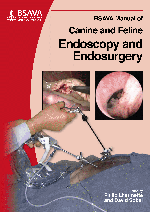
Full text loading...

PLEASE NOTE THAT A MORE RECENT EDITION OF THIS TITLE IS AVAILABLE IN THE LIBRARY
The lower gastrointestinal (GI) tract of the dog and cat is much simpler in its anatomical structure compared with many other species, comprising a simple tube which is divided into the caecum, colon, rectum and anus. As a result of this simple structure and the accessibility of the lower bowel, it is particularly well suited to examination by flexible endoscopy, which is fortunate because disease of the colon is very commonly seen in small animal practice. Previously, radiographs, barium studies and possibly laparotomy to obtain biopsy samples were required, which was time-consuming and expensive. Endoscopy provides a simple and readily available method examining the entire mucosal surface of the lower bowel and permitting collection of biopsy samples to ensure a definitive diagnosis is obtained, which has revolutionized the diagnosis of lower bowel disorders in most patients. This chapter looks into Indications; Instrumentation; Patient preparation; Premedication and procedure; Patient and positioning; Procedure; and Pathological conditions.
Flexible endoscopy: lower gastrointestinal tract, Page 1 of 1
< Previous page | Next page > /docserver/preview/fulltext/10.22233/9781905319572/9781905319572.5-1.gif

Full text loading...




















